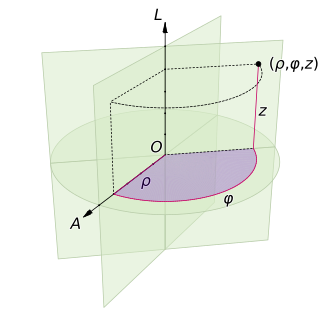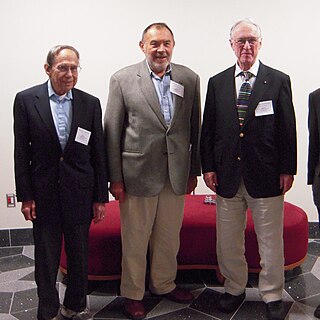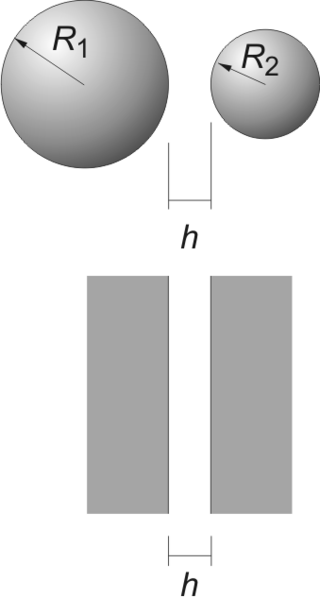In physics, the cross section is a measure of the probability that a specific process will take place when some kind of radiant excitation intersects a localized phenomenon. For example, the Rutherford cross-section is a measure of probability that an alpha particle will be deflected by a given angle during an interaction with an atomic nucleus. Cross section is typically denoted σ (sigma) and is expressed in units of area, more specifically in barns. In a way, it can be thought of as the size of the object that the excitation must hit in order for the process to occur, but more exactly, it is a parameter of a stochastic process.

The surface area of a solid object is a measure of the total area that the surface of the object occupies. The mathematical definition of surface area in the presence of curved surfaces is considerably more involved than the definition of arc length of one-dimensional curves, or of the surface area for polyhedra, for which the surface area is the sum of the areas of its faces. Smooth surfaces, such as a sphere, are assigned surface area using their representation as parametric surfaces. This definition of surface area is based on methods of infinitesimal calculus and involves partial derivatives and double integration.

A cylindrical coordinate system is a three-dimensional coordinate system that specifies point positions by the distance from a chosen reference axis (axis L in the image opposite), the direction from the axis relative to a chosen reference direction (axis A), and the distance from a chosen reference plane perpendicular to the axis (plane containing the purple section). The latter distance is given as a positive or negative number depending on which side of the reference plane faces the point.
In theoretical physics, twistor theory was proposed by Roger Penrose in 1967 as a possible path to quantum gravity and has evolved into a widely studied branch of theoretical and mathematical physics. Penrose's idea was that twistor space should be the basic arena for physics from which space-time itself should emerge. It has led to powerful mathematical tools that have applications to differential and integral geometry, nonlinear differential equations and representation theory, and in physics to general relativity, quantum field theory, and the theory of scattering amplitudes. Twistor theory arose in the context of the rapidly expanding mathematical developments in Einstein's theory of general relativity in the late 1950s and in the 1960s and carries a number of influences from that period. In particular, Roger Penrose has credited Ivor Robinson as an important early influence in the development of twistor theory, through his construction of so-called Robinson congruences.

A Gabriel's horn is a type of geometric figure that has infinite surface area but finite volume. The name refers to the Christian tradition where the archangel Gabriel blows the horn to announce Judgment Day. The properties of this figure were first studied by Italian physicist and mathematician Evangelista Torricelli in the 17th century.

In geometry, Barbier's theorem states that every curve of constant width has perimeter π times its width, regardless of its precise shape. This theorem was first published by Joseph-Émile Barbier in 1860.

Thomson scattering is the elastic scattering of electromagnetic radiation by a free charged particle, as described by classical electromagnetism. It is the low-energy limit of Compton scattering: the particle's kinetic energy and photon frequency do not change as a result of the scattering. This limit is valid as long as the photon energy is much smaller than the mass energy of the particle: , or equivalently, if the wavelength of the light is much greater than the Compton wavelength of the particle.
The Unruh effect is a theoretical prediction in quantum field theory that states that an observer who is uniformly accelerating through empty space will perceive a thermal bath. This means that even in the absence of any external heat sources, an accelerating observer will detect particles and experience a temperature. In contrast, an inertial observer in the same region of spacetime would observe no temperature.

A cylinder has traditionally been a three-dimensional solid, one of the most basic of curvilinear geometric shapes. In elementary geometry, it is considered a prism with a circle as its base.

The ADM formalism is a Hamiltonian formulation of general relativity that plays an important role in canonical quantum gravity and numerical relativity. It was first published in 1959.

In geometry, the napkin-ring problem involves finding the volume of a "band" of specified height around a sphere, i.e. the part that remains after a hole in the shape of a circular cylinder is drilled through the center of the sphere. It is a counterintuitive fact that this volume does not depend on the original sphere's radius but only on the resulting band's height.

In geometry, Cavalieri's principle, a modern implementation of the method of indivisibles, named after Bonaventura Cavalieri, is as follows:

The Derjaguin approximation (or sometimes also referred to as the proximity approximation), named after the Russian scientist Boris Derjaguin, expresses the force profile acting between finite size bodies in terms of the force profile between two planar semi-infinite walls. This approximation is widely used to estimate forces between colloidal particles, as forces between two planar bodies are often much easier to calculate. The Derjaguin approximation expresses the force F(h) between two bodies as a function of the surface separation as

A stadium is a two-dimensional geometric shape constructed of a rectangle with semicircles at a pair of opposite sides. The same shape is known also as a pill shape, discorectangle, obround, or sausage body.
A depletion force is an effective attractive force that arises between large colloidal particles that are suspended in a dilute solution of depletants, which are smaller solutes that are preferentially excluded from the vicinity of the large particles. One of the earliest reports of depletion forces that lead to particle coagulation is that of Bondy, who observed the separation or "creaming" of rubber latex upon addition of polymer depletant molecules to solution. More generally, depletants can include polymers, micelles, osmolytes, ink, mud, or paint dispersed in a continuous phase.

In four-dimensional geometry, the spherinder, or spherical cylinder or spherical prism, is a geometric object, defined as the Cartesian product of a 3-ball of radius r1 and a line segment of length 2r2:
The Ellis wormhole is the special case of the Ellis drainhole in which the 'ether' is not flowing and there is no gravity. What remains is a pure traversable wormhole comprising a pair of identical twin, nonflat, three-dimensional regions joined at a two-sphere, the 'throat' of the wormhole. As seen in the image shown, two-dimensional equatorial cross sections of the wormhole are catenoidal 'collars' that are asymptotically flat far from the throat. There being no gravity in force, an inertial observer can sit forever at rest at any point in space, but if set in motion by some disturbance will follow a geodesic of an equatorial cross section at constant speed, as would also a photon. This phenomenon shows that in space-time the curvature of space has nothing to do with gravity.
Rayleigh–Gans approximation, also known as Rayleigh–Gans–Debye approximation and Rayleigh–Gans–Born approximation, is an approximate solution to light scattering by optically soft particles. Optical softness implies that the relative refractive index of particle is close to that of the surrounding medium. The approximation holds for particles of arbitrary shape that are relatively small but can be larger than Rayleigh scattering limits.
In mathematics, the theory of finite sphere packing concerns the question of how a finite number of equally-sized spheres can be most efficiently packed. The question of packing finitely many spheres has only been investigated in detail in recent decades, with much of the groundwork being laid by László Fejes Tóth.


















